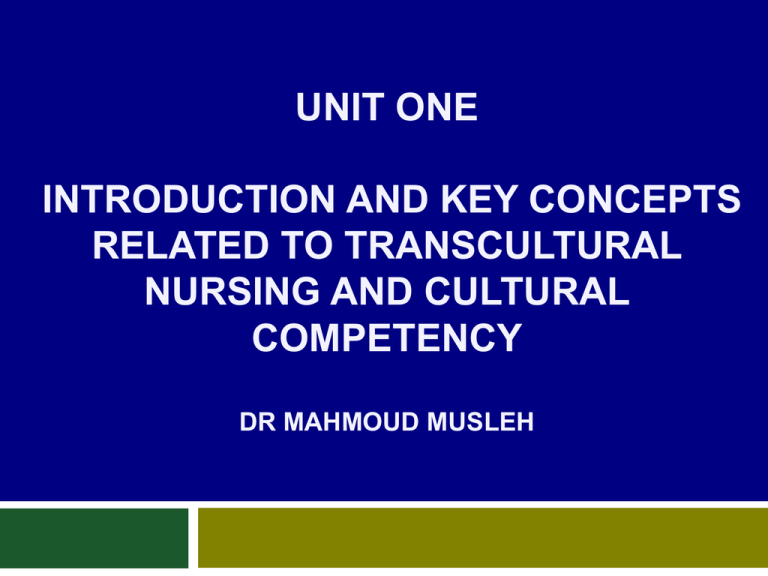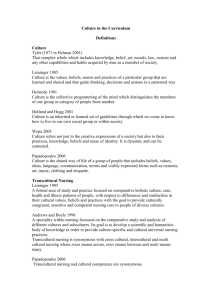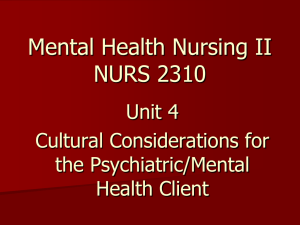UNIT ONE INTRODUCTION AND KEY CONCEPTS RELATED TO TRANSCULTURAL NURSING AND CULTURAL
advertisement

UNIT ONE INTRODUCTION AND KEY CONCEPTS RELATED TO TRANSCULTURAL NURSING AND CULTURAL COMPETENCY DR MAHMOUD MUSLEH Objectives 2 After the completion of this chapter the student will be able to Identify the key concepts of transculture nursing. Discuss the concepts of culture, ethnicity, race, ethnocentrism, and stereotyping. Describe the health practices in different cultures. INTRODUCTION 3 The concept of transcultural nursing appeared less than 30 years ago since Madeleine Leininger first began to develop a theory of transcultural nursing as part of a doctoral study in anthropology. Much has changed in that time, and nursing staff development and in-service educators need to provide education within a multicultural context in a timely manner. 4 Transcultural Nursing was developed because of the need to work with people from widely divergent cultural atmosphere. People from various cultures and subcultures are more common in today’s world and these people are sensitive to the preservation of their cultural heritage and customs. 5 It is critical that nurses, because of their direct patient care, understand and work effectively within this diverse cultural atmosphere. Transcultural scholars and academics refer to care as a universal phenomenon that transcends cultural boundaries, and their aim is to incorporate transcultural nursing into nursing curricula and clinical practices through a research-based knowledge of cultures 6 The most important aspect in developing cultural competence is understanding the interrelatedness of cultural concepts. It is suggested that these definitions be used as a first step toward understanding the complex and dynamic nature of culture. Discussion of these definitions promotes reflection on some of the challenges, contradictions, and ambiguity inherent in the process of becoming culturally competent. DEFINITION 7 The term of transcultural nursing is sometimes used interchangeably with cross-cultural, intercultural or multicultural nursing. In analyzing the Latin derivations of the prefixes associated with these terms, you will notice that trans means across, inter means between, and multi means many Transcultural nursing is an area of study or practice that takes into account the specific values, beliefs, and ways of life of people of diverse or similar cultures, with the goal of using this knowledge in creative ways to provide culturally congruent care. KEY CONCEPTS 8 Understanding the following central concepts is important for understanding the major transcultural models that explore the various aspects of Transcultural Nursing Phenomenon Culture 9 refers to knowledge, beliefs, behaviors, ideas, attitudes, values, habits, customs, languages, symbols, rituals, ceremonies, and practices that are unique to a particular group of people. CHARACTERISTICS OF CULTURE 10 • Culture is learned and taught. Cultural knowledge is transmitted from one generation to another. A person is not born with cultural concepts but instead learns them through socialization. • Culture is shared. The sharing of common practices provides a group with part of its cultural identity. CHARACTERISTICS OF CULTURE 11 • Culture is social in nature. Culture develops in and is communicated by groups of people. • Culture is dynamic, adaptive, and ever-changing. Adaptation allows cultural groups to adjust to meet environmental changes. Cultural change occurs slowly and in response to the needs of the group. This dynamic and adaptable nature allows a culture to survive. Cultural Awareness 12 A cognitive process in which the nurse becomes aware of and sensitive to the client’s cultural values, beliefs, and practices Subculture is closely related to culture, but refers to subgroups who deviate in certain ways from a dominant culture in values, beliefs, norms, moral codes, and ways of living with some distinctive features that characterize their unique lifeway's Cultural Sensitivity 13 Cultural sensitivity is experienced when neutral language–both verbal and nonverbal–is used in a way that reflects sensitivity and appreciation for the diversity of the other It is conveyed when words, phrases, categorizations, etc. are intentionally avoided, especially when referring to any individual who may interpret them as impolite or offensive 14 Cultural sensitivity is expressed through behaviours that are considered polite and respectful by the other Such behaviours may be expressed in the choice of words, use of distance, negotiating with established cultural norms of others, etc. Acculturation 15 Acculturation is the process of incorporating some of the cultural attributes of the larger society by diverse groups, individuals, or peoples The process of acculturation is bi-directional, affecting both the host and target individual or communities in culture contact. Acculturation considers the psychological processes of cultural contact between two or more cultural groups involving some degree of acculturative stress and possibly syncretism leading to new cultural variations and innovations Cultural Competence 16 Cultural competence is defined as the attitudes, knowledge, and skills necessary for providing quality care to diverse populations Competence is an ongoing process that involves accepting and respecting differences and not letting one’s personal beliefs have an undue influence on those whose worldview is different from one’s own Cultural Competence includes having general cultural as well as cultural-specific information so the health care provider knows what questions to ask Cultural Imposition 17 Cultural imposition intrusively applies the majority cultural view to individual and families Prescribing a special diet without regard to the client’s culture, and limiting visitors to immediate family borders is cultural imposition In this context, health care providers must be careful in expressing their cultural values too strongly until cultural issues are more fully understood Discrimination 18 Discrimination occurs when a person acts on prejudice and denies another person one or more of his or her fundamental rights Direct discrimination occurs when someone is treated differently, based upon race, religion, colour, national origin, gender, age, disability, sexual orientation, familial/marital status, prior arrest/conviction record, etc. 19 Indirect discrimination occurs when someone is treated differently based on an unfair superimposed requirement that gives another group the advantage Discrimination results in disrespect, marginalization or disregard of rights and privileges of others who are different from one’s own background. This may be evident in different forms such as ageism, sexism, racism, etc. Diversity 20 Diversity as an all-inclusive concept, and includes differences in race, colour, ethnicity, national origin, and immigration status (refugee, immigrant, or undocumented), religion, age, gender, sexual orientation, ability/disability, political beliefs, social and economic status, education, occupation, spirituality, marital and parental status, urban versus rural residence, enclave identity, and other attributes of groups of people in society Health Disparity and Healthcare Disparity 21 Health disparities are differences in the incidence, prevalence, mortality, and burden of disease and other adverse health conditions that exist among specific population groups The definition of health disparities assumes not only a difference in health but a difference in which disadvantaged social groups—who have persistently experienced social disadvantage or discrimination—systematically experience worse health or greater health risks than more advantaged social groups 22 Consideration of who is considered to be within a health-disparity population has policy and resource implications A healthcare disparity is defined as a difference in treatment provided to members of different racial (or ethnic) groups that is not justified by the underlying health conditions or treatment preferences of patients 23 These differences are often attributed to conscious or unconscious bias, provider bias, and institutional discriminatory policies toward patients of diverse socioeconomic status, race, ethnicity, and/or gender orientation. Labeling and Stereotyping 24 Problems arise when differences across and within cultural groups are misunderstood. Misperception, confusion, and ignorance often accompany people’s expectations of others. There are numerous ways in which people are different and, thus, classified by others. WAYS IN WHICH PEOPLE DIFFER 25 • Age, gender & educational level • Language • Occupation • Residence (rural, urban, suburban) • Socioeconomic status • Religion • Functional abilities • Cognitive abilities • Racial composition • Nationality • Family structure and ties 26 Stereotyping is an expectation that all people within the same racial, ethnic, or cultural group act alike and share the same beliefs and attitudes. Stereotyping results in labeling people according to cultural preconceptions; therefore, an individual’s unique identity is often ignored. Ethnicity 27 A term that relates to races or large groups of people classified according to common traits or customs. Religion is usually a formalized set of beliefs about the nature and existence of God and an afterlife. Ethnocentrism is the belief that one’s own culture is superior to all others. Race 28 A term related to biology, since members of the same group share distinguishing physical features such as skin colour, bone structure, and blood group (Dowd et al., 1998). Racism is usually an intense dislike of others based on race Ethnography 29 The study of a culture. The methodological approach of ethnographic research central to the nurse's ability to develop a heightened awareness of culturally diverse needs of individuals is to define a field for observation for study of the environment and its people as well as the reciprocal relationship that exists between the two (Tripp-Reimer and Dougherty, 1985). Culture shock 30 A disorder that occurs in response to transition from one cultural setting to another. Example a North A merican who goes to live in Japan may experience culture shock through not fully understanding the difference between the USA and Japan culture Cultural bias : strong Cultural biases usually lead to open resistance and negative relationships with clients and staff Cultural blindness 31 refers to the inability of an individual to recognize or see one's own lifestyle, values, and modes of acting as those based largely on ethnocentric and biased tendencies. The nurse was "blind" to recognize and accept what the client did and had told her. She did not accommodate the Arab-Muslim's prayer time HEALTH PRACTICES IN DIFFERENT CULTURES 32 Use of Protective Objects Protective objects can be worn or carried or hung in the home- charms worn on a string or chain around the neck, wrist, or waist to protect the wearer from the evil eye or evil spirits. Use of Substances It is believed that certain food substances can be ingested to prevent illness 33 e.g. eating raw garlic or onion to prevent illness or wear them on the body or hang them in the home. Religious Practices Burning of candles, rituals of redemption etc.. Traditional Remedies The use of folk or traditional medicine is seen among people from all walks of life and cultural ethnic back ground. 34 Healers Within a given community, specific people are known to have the power to heal. Immigration Immigrant groups have their own cultural attitudes ranging beliefs and practices regarding these areas. 35 Gender Roles In many cultures, the male is dominant figure and often they take decisions related to health practices and treatment. In some other cultures females are dominant. In some cultures, women are discriminated in providing proper treatment for illness. 36 Beliefs about mental health Mental illnesses are caused by a lack of harmony of emotions or by evil spirits. Problems in this life are related to transgressions committed in a past life. Economic Factors Factors such as unemployment, underemployment, homelessness, lack of health insurance poverty prevent people from entering the health care system. 37 Time orientation It is varies for different cultures groups. Personal Space Respect the client's personal space when performing nursing procedures. The nurse should also welcome visiting members of the family and extended family. 38 Personal Space Respect the client's personal space when performing nursing procedures. The nurse should also welcome visiting members of the family and extended family.

